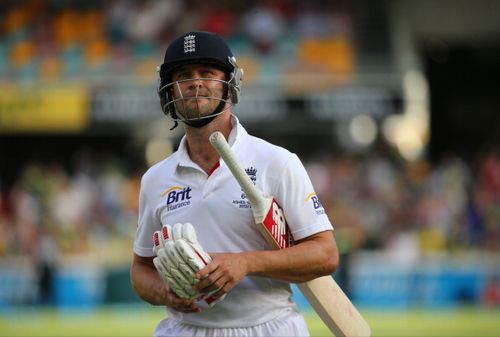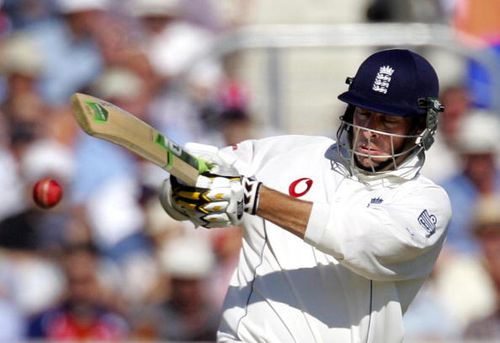
Jonathan Trott: Laid low by stress; a clarion call to tame a growing beast

Jonathan Trott
The alleys must have all turned dark. The narrow lanes that inhabit the maze that lies between the ears seem to have clogged all at once. The talents of a cricketer, which many shall acknowledge to be beyond ordinary, suddenly suffered a bout of dizzying numbness. Amidst one more episode of a cricketer laid low by a deviant delivery of depressive angst, the game has another opportunity to examine its structure and evolve for the future. It remains to be seen if cricket is ready to man up to the situation and face the challenges, or fold into the comfort of an illusory cover of shallow gloss. One thing you could be sure about is this – that flight to London would have been a very lonely journey for the besieged Jonathan Trott.
Meanwhile, life is slowly but surely turning full cycle for the cock-a-hoop English team that finds itself marooned Down Under. The broken brothers that Trott left behind in Australia will no doubt be cogitating over the memories surrounding another of their mates from the not-so-distant past. Only six years ago, Marcus Trescothick flew back home after suffering from a similar bout of deprecating self-doubt and trauma. After a few years of often heroic brilliance, the English are a cornered lot against their vengeful Aussie opponents.
It isn’t an easy space to be. One needs to understand the complex world of professional sport and the pursuit of it under the constant glare of unforgiving cameras to appreciate the strength of nerve that is required besides the oodles of talent that goes without saying. Even as cricket is dealing with an explosion of wealth all around, it appears that the men delivering its newest tricks are far from equipped to deal with the stress and strain of the modern day game.
We make our judgements on the little we see on the television screen or around the grounds hosting the parties that please us no end. We are enamoured by their heroics, by their poise and power, as they perform envious tricks with the cherry and wood. It’s almost like judging the book by its cover, only in this case, it is all we can afford to access.
Not many of us have the opportunity to peer behind the glass and experience the innumerable hours of toil perfecting their craft. We are condemned to remain oblivious to the mindless stretching of their sinews in the search for that extra inch. The margins at the top are narrow, and it is but an inch or two that distinguish the unrecognised domestic dilettante from the celebrated international stars.
Only the tough at heart can survive traversing the demanding final mile, covering the painstakingly narrow differences that separate the men from the boys. In the past, even the top men among cricket were afforded the luxury of pursuing their passion in relative obscurity. No doubt they were stars in their own right, but they could get away from it ever so often.
24×7 television and a voracious appetite for live sport have altered the dynamics for today’s generation of cricketers. Just a little more than a decade ago, a misfield at the boundary or a spilt catch was treated with a knowing smile. Cricket was a gentlemen’s pursuit, a sort of garden sport that was characterised as much by its lazy elegance as it was for its exquisite brilliance.
Today’s cricketers can barely afford such a mishap. Cameras pan around their grim visage time and again, magnifying their misdeed with almost vilifying focus, shifting only to capture the captain’s disgust. The exertion of pressure is all too evident for player and spectator, making for a curious spectacle in a very voyeuristic manner. But that is the order of the day.
There is also plenty of money going around, spawning an endless train of matches. The frequency and volume of cricket has made it difficult to figure out whether a season of cricket is starting or finishing. As they travel from one city to another, packing and unpacking their kits and bags, it is easy to empathise with a player who might be wondering if he was coming or going.
The stress builds up over time. And the ephemeral nature of an athlete’s glorification adds spice to the concoction. One day the athlete is drowned in the revelry of celebration, as if he were representing a divine epiphany, and the next morning he is reviled as if the same person embodied some satanic spirit. Somewhere on a flight to yet another cricket stadium, the pleasure of playing is supplanted by the need to protect turf.
There are only so many places in a team for a batsman or a bowler. And there are many seasoned cricketers hunting for that elusive national cap. As soon as the joy gives way to fear, the stress starts eating at the persona of the player. And this is exactly what has happened with Trott. The devil called doubt took over the spaces in his mind that hitherto helped him express his greatest desires with the flowery flourish of the willow.
Trott isn’t an isolated incident; he is another layer of symptomatic evidence of a growing thread of concern. Michael Yardy disappeared even as he was poised to represent England in the 2011 World Cup. The case of Trescothick has been documented all too well to be easily forgotten. Andrew Flintoff and Steve Harmison suffered from the vagaries of doubt too, but were stoic enough to battle their inner demons and prevail over their painful angst.

England’s Marcus Trescothick also flew back home six years ago after a similar ordeal.
In case you are wondering why all of these cases are English, just learn to respect these gentlemen for standing up even under the burden of their worst fears. You can bet a few quid that there are several other players who are dealing with it in the silence of their homes, for their fear of perception is greater than the fear of failure. So learn to respect the men like Trott who summon one last dose of courage to stand up and expose the demon before submitting themselves to the good counsel of a wise doctor.
In the context of this growing menace, it is educating to remember the honest utterings of Trescothick. Speaking to Donald McRae of The Guardian, the southpaw from Somerset spoke about the “beast that lives inside” and “the shiver” that it sends coursing through his squeezed veins. It is a lesson that other cricketers of similar disposition might like to learn from. It appears a similar beast has consumed Trott as well.
The game of cricket needs to jump out of its induced slumber and digest the heap of symptoms that are surrounding its self denying structures. Any further delay and the beasts will start chipping at the edifice, damaging the sport even further. It is imperative for cricket to take a structural approach to address the malignant tumour before it turns fatal.
Of course there cannot be an “one size fits everyone approach.” The countries that cherish the game come from a variety of continents with acute differences in culture and context. Each national board needs to review and identify what might work best in its own fraternity and offer the structural support and grooming needed to prepare the cricketers for the demanding existence that awaits their celebrated lives.